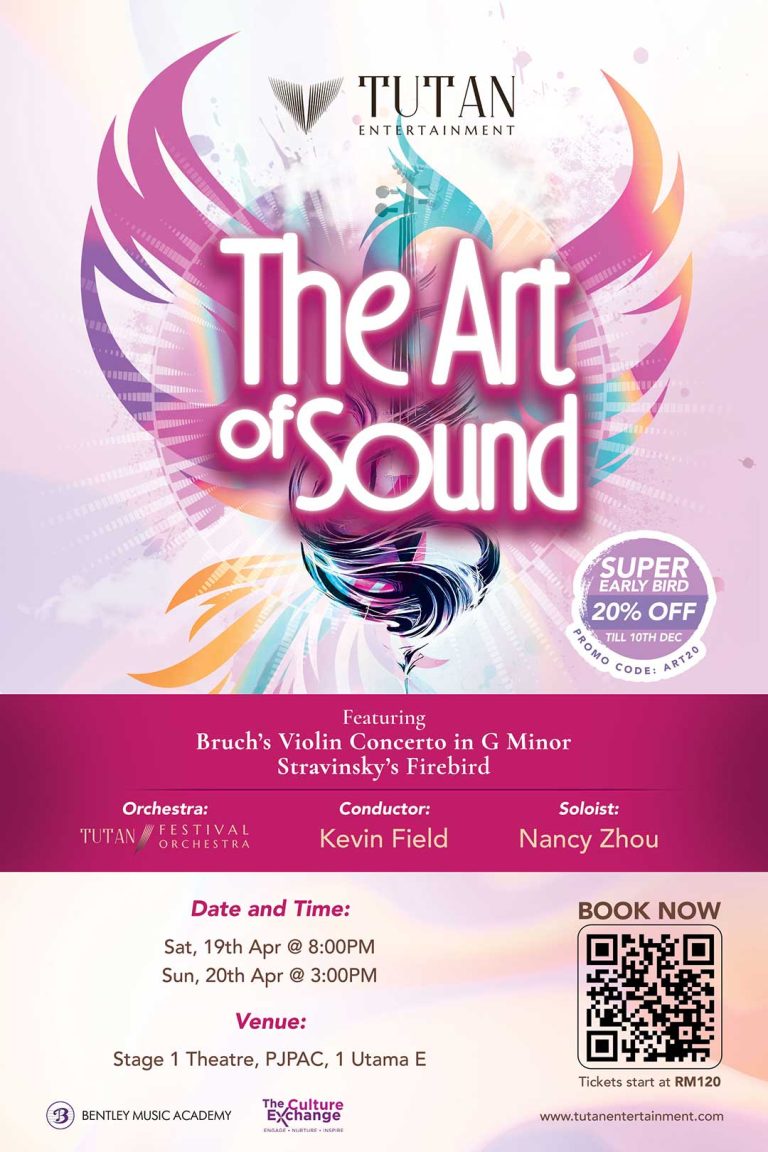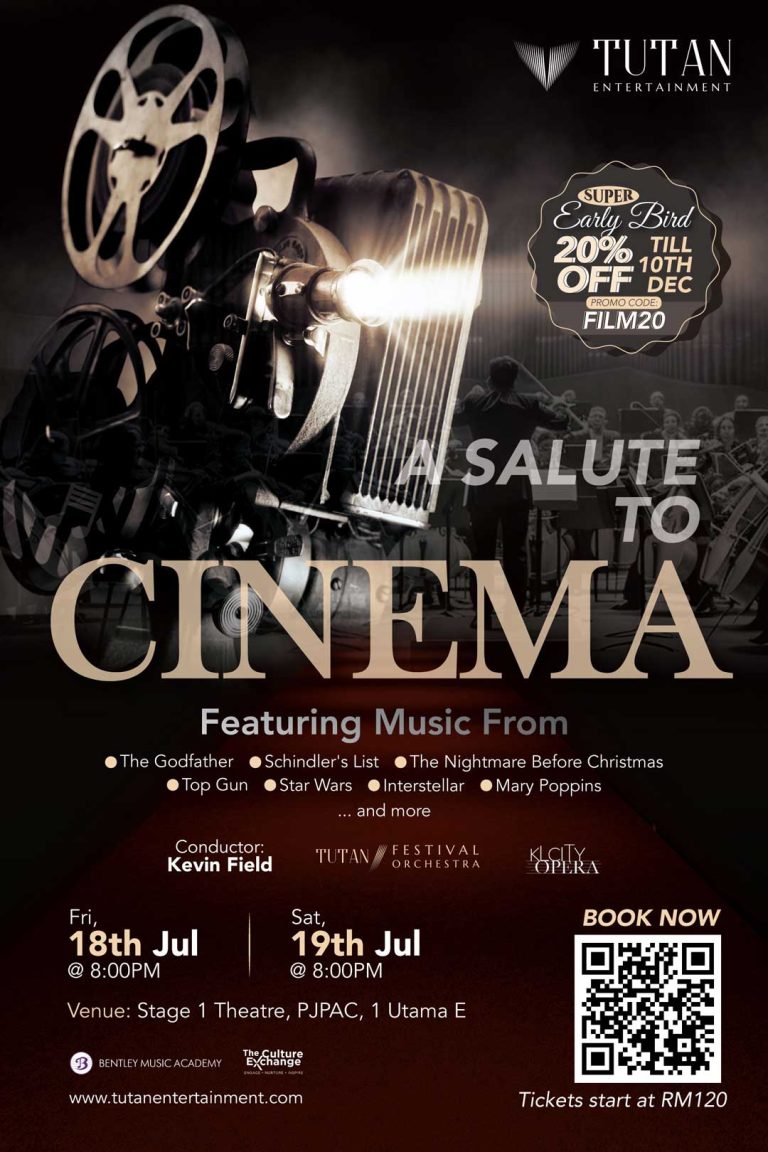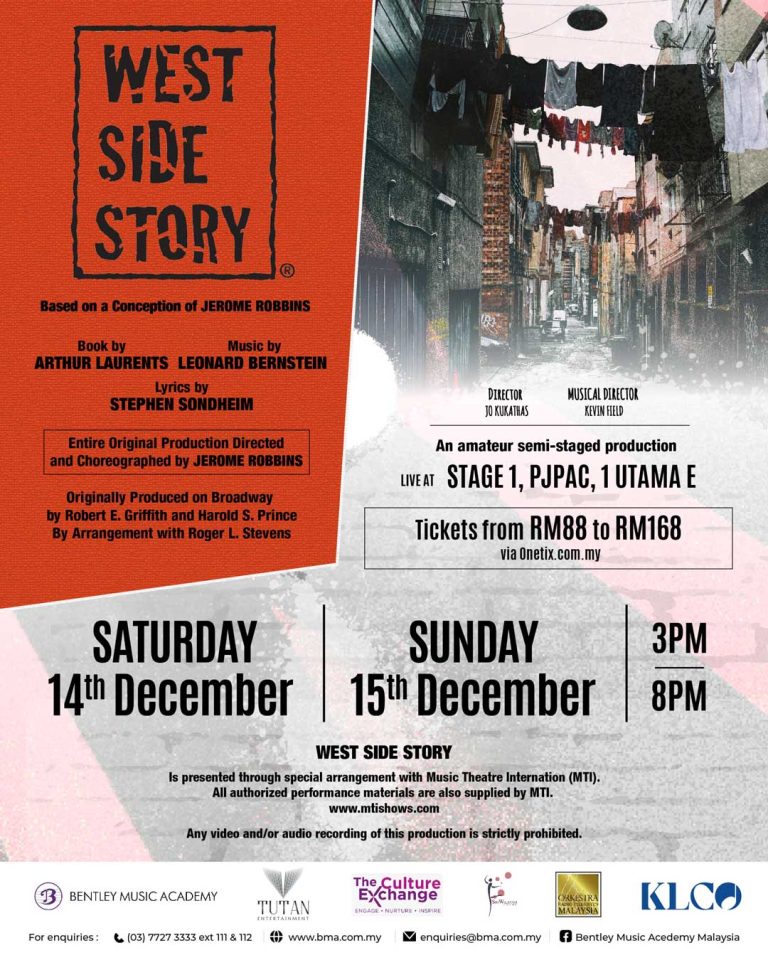
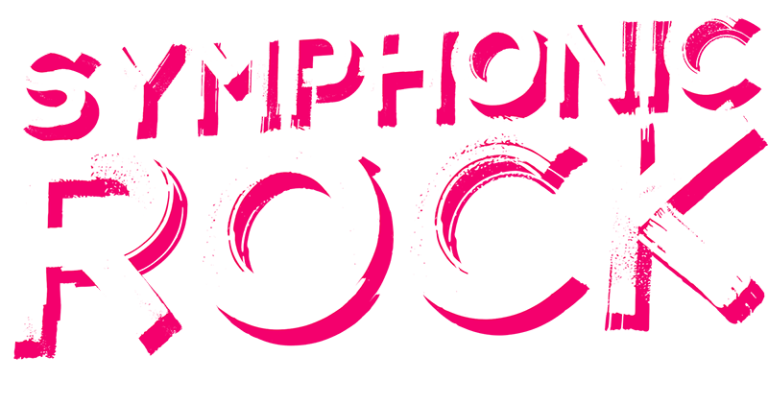
Sat
16th Nov | 8.00pm
Sun
17th Nov | 3.00pm
Welcome to Symphonic Rock: When Rock and Orchestra Collide
Dear Rock Lovers and Friends,
Welcome to a night like no other! Symphonic Rock is here to take you on a musical journey where the raw power of rock collides with the grandeur of orchestral music. Prepare to be swept off your feet by an epic fusion of iconic anthems and symphonic brilliance.
Our incredible Tutan Festival Orchestra, led by the masterful Kevin Field, has brought together some of the greatest rock hits of all time—reimagined in ways you’ve never experienced before. With soaring vocals and electrifying performances, tonight’s show will take classic rock to a whole new level. And joining us for this unforgettable night are our guest vocalists, Zeela Zaharuddin, Raafik Iskandar and the incredible KL City Opera.
We couldn’t have made this event happen without you, our passionate audience. Your love for music drives us to push boundaries and deliver experiences that stay with you long after the final note fades. Tonight is not just about listening—it’s about feeling every beat, every riff, and every harmony deep in your soul.
So, let’s turn up the volume and let the music take over! Get ready for an explosion of sound, energy, and emotion that will leave you buzzing long after the curtain falls. This is Symphonic Rock—and you’re part of it.
Thank you for being here. Let’s rock!
With excitement,
The Tutan Entertainment Team
Concert Programme
INTERMISSION
20 minutes
About Tutan Entertainment

Elevating Music, Transforming Experiences
At Tutan Entertainment, we’re driven by a passion for sharing the beauty of orchestral music and creating experiences that resonate long after the final note. Our goal is to inspire and uplift through performances that bring symphonic masterpieces to life, thanks to the dedication and talent of our world-class musicians. We believe in making these moments accessible and meaningful for everyone, which is why we are committed to educational outreach and building genuine connections with our audience. With each performance, we strive to make orchestral music a shared and cherished journey.
Our Principles:
Excellence in Performance:
Prioritising artistic integrity, we showcase performers who epitomises the spirit of orchestral music, delivering experiences that linger in memory.
Innovative Spirit:
We reimagine classical music, merging tradition with innovation, exploring diverse collaborations, and transcending conventional boundaries.
Audience Engagement:
We’re passionate about fostering a love for classical music, offering insightful workshops and talks that deepen our audience’s connection to the compositions.
Immersive Experiences:
Our events are not just concerts but journeys. We combine visuals, technology, and unparalleled venues to craft captivating narratives.
Collaborative Spirit:
We champion teamwork, actively partnering with artists and organisations to propel classical and orchestral music into the future.
With your support, Tutan Entertainment is poised to inspire generations, keeping the timeless beauty of symphonic music alive and thriving in our modern world. Join us in this harmonious journey.
Get in Touch with Tutan Entertainment
We love connecting with our community and partners. Whether you have a question, feedback, or are interested in collaborating with us, we’re here to listen. Fill out the form below, and our team will get back to you promptly.
About The Orchestra

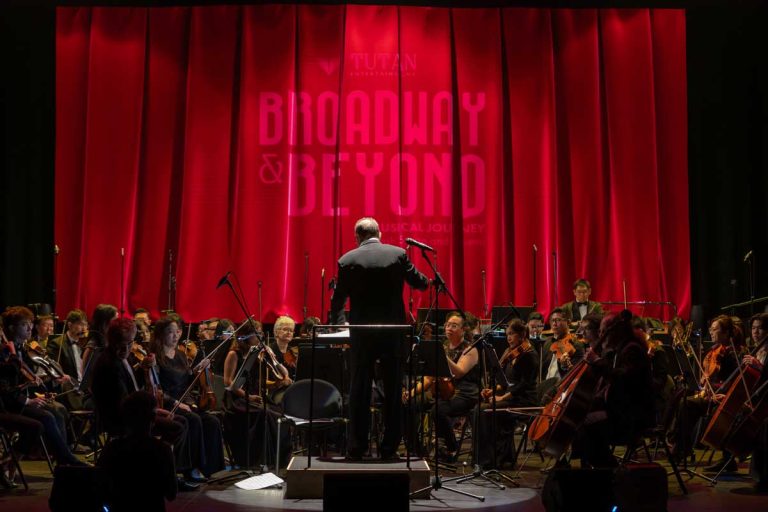
Established in 2023, the Tutan Festival Orchestra is more than just an orchestra; it’s Malaysia’s beacon for classical and orchestral excellence. In a world where music constantly evolves, our orchestra is committed to shining a spotlight on timeless classical symphonies, ensuring they resonate with the modern Malaysian audience and beyond. We are passionate about presenting the grandeur of orchestral masterpieces to both new listeners and classical aficionados, weaving the age-old with the contemporary in a rich musical narrative.
Our commitment reaches far beyond the concert hall’s grandeur. TFO’s orchestral melodies are crafted to enchant audiences from every corner of the globe. With each note played and every masterpiece performed, we aspire to transport listeners into a realm of profound emotion, kindling a deeper admiration for the timeless beauty of orchestral arts.
Music is our medium, community our canvas. Beyond live performances, the Tutan Festival Orchestra dedicates itself to enriching Malaysian communities. Through educational drives, community outreach, and artist incubation initiatives, we don’t just play music; we nurture the budding talents of tomorrow. Our partnerships with schools, local art groups, and community hubs ensure that classical tunes resonate in every corner, inspiring love for the arts and fortifying societal bonds.
About Kevin Field
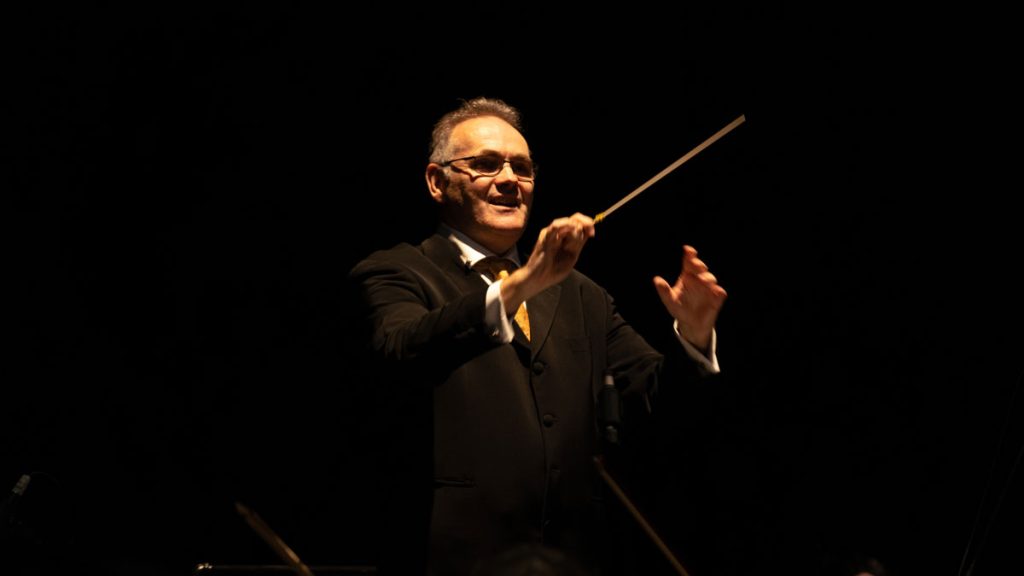
Kevin Field, a distinguished conductor, has showcased his talents with esteemed orchestras including the BBC Symphony, Malaysian Philharmonic, National Symphony Orchestra of Ireland, and the Royal Liverpool Philharmonic Orchestra. His collaborations with global artists are vast, spanning from jazz legends Chick Corea and Gary Burton to Chinese opera virtuoso ShuCheen Yu.
A graduate of the Royal Academy of Music, Kevin commenced his journey with the Bournemouth Symphony Orchestra, founding Kokoro, its contemporary ensemble. This venture saw him touring Europe and the USA extensively, leaving behind a rich discography. His percussion prowess also led him to engagements with the Royal Philharmonic Orchestra and the Orchestra of the Bolshoi Theatre, among others.
Kevin’s dedication to music education shone brightly during his tenure as Associate Conductor with the Malaysian Philharmonic Orchestra (1999-2014). There, he pioneered the Malaysian Philharmonic Youth Orchestra and received accolades for introducing over 180 contemporary pieces to Malaysia. Today, his commitment to musical education continues as the Director of Academic and Artistic Development at Bentley Music Academy, serving over 750 budding musicians across all genres.
Having founded The Culture Exchange to foster cross-border artistic collaborations, Kevin remains a lifelong learner. In 2022, he achieved a Master’s in Creative Events Management from Falmouth University, solidifying his position as a pillar in the world of classical music.
Kevin Field appears courtesy of Bentley Music Academy

About the Kuala Lumpur City Opera

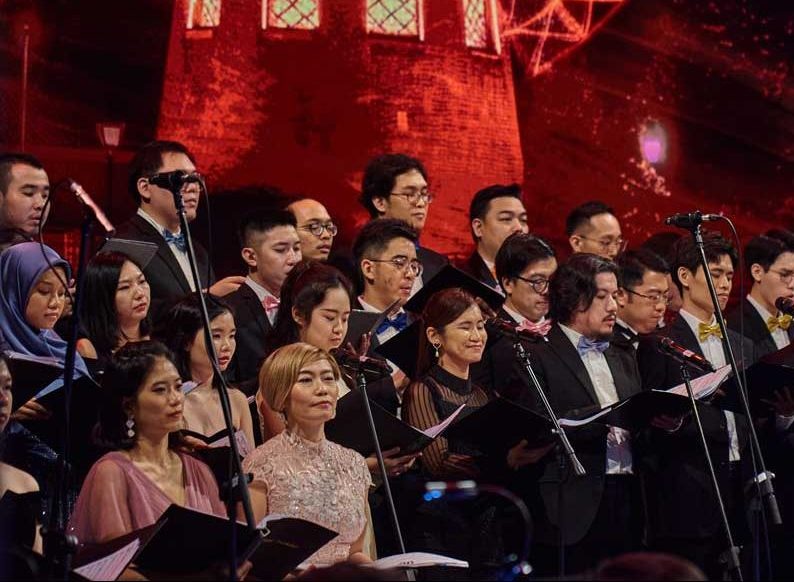
KLCO continues to produce various full length western operas namely Bizet’s Carmen (2013, 2023), Menotti’s Amahl & the Night Visitors (2014), Donizetti’s Elisir D’amore (2014, 2023), Puccini’s La Boheme (2012 & 2016), Donizetti’s La Fille Du Regiment (2017), Humperdinck’s Hansel & Gretel (2018), Puccini’s Madama Butterfly (2018), Verdi’s La Traviata (2019), Mozart’s Die Zauberflöte (2019) and Poulenc’s La Voix Humaine (2022), to name a few. Our concert series includes Viva Verdi Bicentenary Concert (2013), Voices & Winds: Coronation Mass (2014), Can You Handel This? (2014), KLCO Fundraising Concert (2015), Opera Gala Spectacular (2016 & 2017), and Voice of Our Children (2024).
We are also the proud organiser of Kuala Lumpur’s inaugural opera festival, OperaKUL (2016, 2017 & 2021), a collaboration with MAPKL Festival, and awarded as winner of Cameronian Arts Awards in the Music Category, and most recently awarded best Group Performance in the 18th Boh Cameronian Arts Awards for the performance of “A Grand Night of Opera”. In the same year, the chorus was awarded a Gold Status by the Malaysian Choral Eisteddod (MCE), an international recognition.
Kuala Lumpur City Opera Chorus have collaborated, performed with the Malaysian Philharmonic Orchestra’s Mozart’s The Magic Flute (2017), Russian Bells & Eugene Onegin (2018), and Verdi’s La Traviata (2023) at the Dewan Filharmonik Petronas. In 2018, our Opera Chorus sang with the Rossini Academia, and subsequently with Teatro Regio di Parma, both from Italy. A year later, the Chorus was invited to sing in Bizet’s Carmen produced by the Singapore Lyric Opera (SLO) at the Esplanade, Singapore.
About Zeela Zaharudin

With a Bachelor’s Degree in Music & Popular Music from the University of Wolverhampton, UK, Zeela Zaharudin brings a wealth of experience and versatility to her performances. Her vocal expertise, honed under the guidance of renowned mentors such as Karen Radcliffe (Voice), has seen her take the stage in genres ranging from rock and pop to jazz and classical, in both the UK and Malaysia.
In addition to her vocal talents, Zeela is an accomplished multi-instrumentalist and session musician, known for her dynamic performances and passion for teaching. As the female soloist for Symphonic Rock, her powerful voice will take centre stage, blending seamlessly with orchestral arrangements to bring iconic rock songs to life. Currently, Zeela is also working on her upcoming solo EP and performs as a vocalist and keyboardist in the progressive band Paid in Fiction.
About Raafik Iskandar
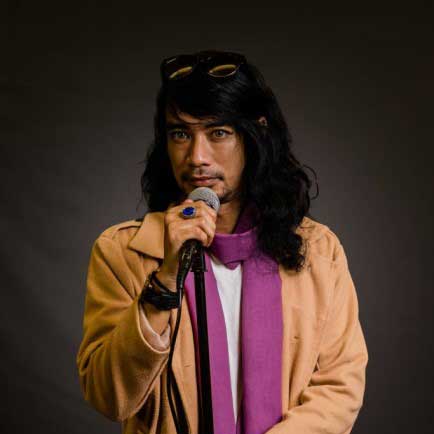
Raafik Iskandar, a highly skilled vocalist with over two decades of music experience, brings a unique depth and versatility to every performance. A graduate of Lasalle SIA College of the Arts in Singapore, Raafik’s vocal prowess spans various genres, from rock and pop to traditional and classical influences. Known for his powerful and emotive voice, he has performed on prominent stages across Singapore, including the Esplanade and on Suria TV.
As a vocal instructor, Raafik has honed his ability to guide and inspire students while continuing to refine his own craft. His passion for vocals has been at the forefront of his teaching and performing career, making him a sought-after figure in the Singaporean music scene.
For Symphonic Rock, Raafik steps into the spotlight, delivering dynamic vocal performances that fuse the energy of rock with the grandeur of orchestral accompaniment. His commanding voice, combined with his stage presence, will undoubtedly captivate the audience, making this an unforgettable performance.
Tutan Festival Orchestra Performers
Violin 1
- Hyungi Kim**
- Abdul Hadi bin Ahmad Razli
- Andrea Sim
- Vira Nyezhentseva
- Philip Jeremy Law Tze Siang
- Kylie Tan
- Kyvie Tan
- Ian Yoon Zhao-Xuan
- Nur Izwani Binti Ismail
- Melanie Ooi Yong Li
- Ezra Mulyawan
Violin 2
- Mabel Wong Yih Ping*
- Lee Hai Lin
- Chiah Jing Yuan
- Lim Shau Ming
- Esther Lee Xian Ni
- Yii Yao
- Chew Evangeline
- Chiah Jing Yuan
- Euven Liaw You Wen
- Ong Liyen
- Lee Yi En
Viola
- Angela Lou Chai Hong*
- Cheryl Choi
- Lee Kok Leong
- Beverly Tan Zhen
- Dylan Lai Jun-Yi
- Wong Yu Yong
- Tan Jing Rui
- Oliver Gwee
Cello
- Ivan Tores*
- Chong Eugene
- Lim Tze Yao (Ryan)
- Aidil Khaizir bin Kamarudin
- Melany Yoon
- Diong Wen-Xin
- Tariq Zikri bin Zulkifli
- Gideon Kong Min Jyn
Double Bass
- Yukari Sasada*
- Lee Teck Keong
- Yong Yoon May
- KoK Keng Onn
- Alvin Ong Siau Shun
Horn
- Mohd Adznan Bin Mokhtar*
- Marvin Loh Zi Shun
- Mohd Faris bin Romzy
- Chai Kee Hong
Clarinet
- Alex Tsok Kian Hung*
- Yong Song Yeu
Flute
- Chai Yem Voon*
- Jenny Zhao Chu Jian
- Lawrence Chiu Peng Chong
Oboe
- Yong How Keen
- Tan Jie Er
Bassoon
- Rianne Wong
- Amir Syafiq bin Hisham
Trumpet
- Jonathan Baird*
- Woon Sze Sheng
- Wong Sze Yen (Kay)
Trombone
- Chia Pei Jing*
- Yap Jun Wei
- Abdul Hanif Bin Abd Hamid
Tuba
- Pang Hung Yi
Timpani / Percussion
- Jing Wan
- Nian Shee*
- Li Yang
- Han Chao
Piano
- Alice Ang Ying Ying
Bass Guitar
- Muhamad Nurwafi Bin Norzahan
Guitar
- Mohd. Zairul Azreen Shah
Drums
- Boon Soon Fatt
Note:
** Concertmaster
* Section Principal
Kuala Lumpur City Opera Chorus
Chorusmaster
- Chi Hoe Mak
Soprano 1
- Lum Wan Zhen
- Renna Nayeon Kim
- Tan Pyen
- Tay Mi Shyuan
- Zoey Lee
Soprano 2
- Jocelyn Chew*
- Natalie Makulin*
- Eva Juric Lim
- Ginny Choong
- Grace Loo Jia En
- Helen Long
- Low Hui Xin
- Sue Xian Eiap
- Sharon Chong
Alto
- Nina Wong De Ling*
- Aisyah Nadiah
- Angela Lua Wei Wei
- Jan Yuen
- Margaret Wing
- Natellie Chee Foong Wah
- Sharon Kaur
- Wong Min Xin
- Christine Cheng
Tenor
- Jonathan Ling*
- Chong Koi Min*
- Adam Oakley
- Andrew Lai Chii Horng
- Tan Guan Lin (Johnson)
- Isa Zamiri
- Thomp Yunga
- Brandon Chiah
Baritone & Bass
- Joshua Andy Chong*
- Qahar Aqilah*
- Adam Shamshul
- Aldwin Lee
- Logan Chai
Note:
(*) Section Lead
Programme Notes
A Whiter Shade of Pale | Procol Harum
( Feat. the KLCO )
Released in 1967, “A Whiter Shade of Pale“ became an anthem of the Summer of Love, with its enigmatic lyrics and haunting melody. The song’s distinctive organ riff is heavily inspired by Johann Sebastian Bach’s Air on the G String and Sleepers, Awake. Its lyrics, penned by Keith Reid, are often seen as cryptic and surreal, possibly influenced by Bob Dylan’s poetic style. Despite its ambiguity, the song was an instant hit and has since been covered by numerous artists.
Procol Harum emerged from the British rock scene in the late 1960s, a time when psychedelic and progressive rock were pushing musical boundaries. Led by vocalist and pianist Gary Brooker, the band was known for fusing classical music influences with rock, creating a distinctive and sophisticated sound. Procol Harum played a significant role in the early development of progressive rock and baroque pop, and their music is often characterised by its intricate arrangements and philosophical lyrics. Though A Whiter Shade of Pale remains their most iconic song, the band continued to release critically acclaimed albums that blended rock, blues, and classical elements throughout their career.
Their influence extended beyond just music; they helped pave the way for later bands like The Moody Blues and King Crimson, who furthered the fusion of rock and classical music. Procol Harum’s willingness to experiment with unconventional song structures and lyrical themes set them apart from their contemporaries and solidified their place in rock history.
Fun Fact: “A Whiter Shade of Pale” has earned legendary status over the years. Inducted into the Grammy Hall of Fame in 1998, it was later recognised by Phonographic Performance Limited as the most-played record in British broadcasting over 70 years. It also ranked 57th on Rolling Stone’s list of “The 500 Greatest Songs of All Time.” By 2009, it was crowned the most-played song in public places in the UK over the last 75 years—an enduring testament to its timeless appeal!
Vida la Vida | Coldplay
( Feat. the Raafik )
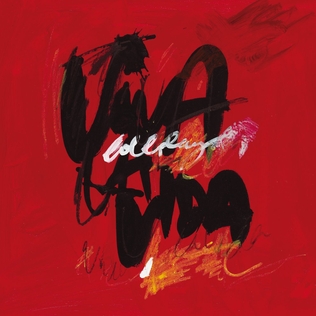
Coldplay’s 2008 hit “Viva La Vida“ is one of the band’s most defining songs, known for its sweeping orchestral elements and grandiose sound. The song’s themes revolve around revolution, the rise and fall of empires, and personal downfall, with a strong sense of reflection on power and its transient nature.
Coldplay, formed in London in 1996, quickly became one of the most influential bands of the 21st century. Their debut album Parachutes (2000) brought them into the spotlight with their atmospheric rock sound and introspective lyrics, influencing a generation of alternative rock bands. Led by Chris Martin, their music is characterised by emotional depth and sweeping melodies, and they’ve been praised for their ability to blend rock with pop and electronic elements. Coldplay’s willingness to experiment with sound while maintaining an emotional connection with their audience has made them a dominant force in modern music.
“Viva La Vida,” from their fourth studio album Viva La Vida or Death and All His Friends, marked a turning point in Coldplay’s career. Under the guidance of producer Brian Eno, the band embraced a more experimental and orchestral sound. The song is notable for its lush string arrangements, absence of guitar, and rhythmic percussion. The lyrics, written from the perspective of a deposed king reflecting on the fleeting nature of power, are filled with religious and historical allusions, adding to the song’s depth and universal appeal.
The track became a global success, topping charts in multiple countries and winning the Grammy Award for Song of the Year in 2009. Viva La Vida solidified Coldplay’s status as innovators in the music world, further establishing their ability to create songs that resonate both musically and thematically with a wide audience.
Fun Fact: “Viva La Vida” means “Live the Life,” and the title is inspired by a painting by Mexican artist Frida Kahlo, who embraced life despite personal suffering.
Queens of Rock Medley
( Feat. Zeela and the KLCO )
Ship To Wreck | Florence & The Machine
Released in 2015 as part of the album How Big, How Blue, How Beautiful, “Ship to Wreck” showcases Florence Welch’s ability to juxtapose lively, driving melodies with deeply personal and introspective lyrics. The song explores themes of self-destruction and internal conflict, resonating with listeners on both personal and universal levels. Florence & The Machine is known for their indie rock and baroque pop influences, with Florence Welch often compared to the likes of Kate Bush for her ethereal vocals and emotive storytelling.
The band has had a significant influence on the indie rock scene, bringing a blend of grandiosity and vulnerability to their music that helped redefine the genre. Welch’s powerful stage presence and her willingness to explore complex emotional themes have made Florence & The Machine one of the most iconic indie acts of the 2010s.
Fun Fact: Florence Welch described writing “Ship to Wreck” as feeling like “letting the floodgates open.” She likened the process to watching herself “create this mess.”
Zombie | The Cranberries
Written in response to the 1993 IRA bombing in Warrington, England, “Zombie” stands as one of the most politically charged songs in The Cranberries‘ discography. Released in 1994 on their album No Need to Argue, the song’s heavy, grungy sound marked a departure from the band’s earlier, more melodic work. Dolores O’Riordan’s raw vocals and the powerful guitar riff helped make “Zombie” an international anthem of resistance and resilience. Its unflinching lyrics address the pain, frustration, and senselessness of violence, giving voice to a generation affected by the Troubles in Northern Ireland.
The Cranberries, known for their unique blend of Irish folk and alternative rock, played a key role in shaping the sound of 90s rock. Dolores O’Riordan’s distinctive voice and the band’s blend of poignant lyricism and powerful instrumentation earned them a lasting legacy in rock music.
Fun Fact: Dolores O’Riordan originally wrote “Zombie” on an acoustic guitar in a small apartment, but the song’s transformation into a heavy, grungy anthem was driven by her desire to create a more aggressive, raw sound to reflect the song’s message of protest and pain.
Bring Me To Life | Evanescence
A defining anthem of early 2000s rock, “Bring Me to Life” launched Evanescence into the mainstream with its release in 2003. The song’s combination of classical piano, Amy Lee’s operatic vocals, and the heavy nu-metal guitar riffs created a unique blend of gothic and rock elements. The song was inspired by Amy Lee’s feelings of emotional isolation and longing for connection. Its exploration of awakening—both literal and emotional—struck a chord with listeners, and it became the band’s breakout hit, earning them a Grammy Award for Best Hard Rock Performance.
Evanescence helped bring gothic rock into the mainstream, influencing a wave of bands that combined heavy metal with symphonic and classical elements. Amy Lee’s haunting voice and the band’s theatrical sound have left a lasting impact on rock music, especially in the realms of gothic and symphonic metal.
Fun Fact: Amy Lee wrote “Bring Me to Life” at 19 after a life-changing conversation with Josh Hartzler, a psychology student who saw through her struggles. His ability to “see into [her] eyes, like open doors”, inspired the song’s lyrics. Years later, Lee and Hartzler fell in love, and they married in 2007. They are still happily married today and have a son together!
Stairway to Heaven | Led Zeppelin
( Feat. Zeela and Raafik )
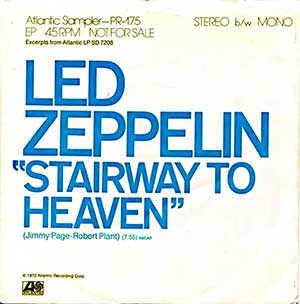
Widely regarded as one of the greatest rock songs ever written, “Stairway to Heaven” is a musical journey that spans multiple genres, from folk to hard rock. Released in 1971 as part of Led Zeppelin’s fourth album, the song was crafted by guitarist Jimmy Page and vocalist Robert Plant. The lyrics are rich with mystical and spiritual imagery, often interpreted as a reflection on the search for meaning and enlightenment. The song begins with a gentle, acoustic guitar intro, building slowly in intensity before culminating in one of the most iconic electric guitar solos in rock history, performed by Jimmy Page.
Despite its enormous popularity, “Stairway to Heaven” was never released as a single, which only added to its mystique. Fans had to purchase the entire album to experience the song, contributing to the album’s massive success. Over the years, the song has been a staple of classic rock radio and continues to be one of the most requested and played songs worldwide.
Led Zeppelin’s influence on rock music cannot be overstated. Known for their innovation, the band combined elements of blues, hard rock, folk, and even classical music, creating a sound that was as powerful as it was diverse. “Stairway to Heaven” is often seen as the pinnacle of their creativity, blending intricate guitar work, poetic lyrics, and dynamic shifts in mood and tempo, all while pushing the boundaries of what rock music could achieve.
Fun Fact: The iconic guitar solo in “Stairway to Heaven”, often considered one of the greatest in rock history, was entirely improvised by Jimmy Page during the recording session. Despite its spontaneous creation, the solo has become one of the most recognisable and celebrated moments in rock music, showcasing Page’s extraordinary skill and creativity.
November Rain | Guns N’ Roses
(Feat. Raffik)
November Rain stands as a towering testament to the ambitious artistry of Guns N’ Roses, released in 1991 on their seminal double album Use Your Illusion I. Written by Axl Rose, the band’s enigmatic frontman, the song merges hard rock with classical influences, showcasing a sophisticated orchestral arrangement that pushed the boundaries of rock music in the early ’90s. Known for its nearly nine-minute runtime, the piece defies conventional song structures, unfolding as a dynamic, emotive journey rather than a standard ballad.
The song’s central themes explore the inevitability of pain and the transience of love. It opens with a contemplative piano melody that immediately sets a sombre tone, evoking a sense of longing and introspection. Rose’s haunting vocals deliver verses filled with vulnerability and a yearning for understanding, building up to the powerful, climactic guitar solos performed by Slash. These solos are among the most recognisable in rock history, contributing to the song’s reputation as an epic and emotionally charged masterpiece.
The orchestration plays a crucial role in amplifying the song’s dramatic atmosphere. With sweeping strings arranged by composer Michael Kamen, November Rain achieves a grandeur that was rare in rock music at the time. Kamen, known for his work with artists like David Bowie and Metallica, lent a symphonic depth that elevates the song from a power ballad to an orchestral rock opus. The fusion of classical elements with the band’s hard rock roots reflects Guns N’ Roses’ ability to experiment beyond the conventions of their genre.
November Rain became an instant classic, securing its place as a cultural touchstone with a music video that was equally ambitious. Directed by Andy Morahan, the video is a visual spectacle featuring dramatic wedding scenes, intricate set pieces, and concert footage. It holds the legacy of being one of the most expensive music videos ever made at the time, symbolising the excess and grandeur of the era.
Fun Fact: Axl Rose’s dedication to November Rain was unparalleled, with early drafts of the song dating back to around 1983. This nearly decade-long development period reflects Rose’s meticulous approach to songwriting and his vision for creating a piece that combined emotional depth with symphonic rock power. The long journey to its final release underscores its importance as not just a song, but a statement of artistic intent for the band.
Iconic Rock Symphony
( Feat. Raafik and the KLCO )
Sweet Child O’ Mine | Guns N’ Roses
What started as a playful warm-up session between guitarist Slash and drummer Steven Adler quickly evolved into one of the most iconic rock songs in history. Released in 1987 on the band’s debut album Appetite for Destruction, “Sweet Child O’ Mine” became Guns N’ Roses’ first No. 1 hit on the Billboard Hot 100. The song’s instantly recognisable opening riff was created by Slash as a guitar exercise, but it became the foundation of the track. Axl Rose’s heartfelt lyrics were written as a tribute to his then-girlfriend, Erin Everly, capturing a sense of youthful romance and idealised love.
Guns N’ Roses, known for their blend of hard rock, punk, and blues, helped define the rock sound of the late 1980s and early 1990s. Their raw energy, combined with their rebellious image, set them apart from the glam metal bands of the time. Sweet Child O’ Mine is one of the band’s more melodic songs, showcasing their ability to balance hard rock riffs with softer, more emotional themes. Its success cemented Guns N’ Roses as one of the most influential rock bands of their era.
Fun Fact: Slash wasn’t fond of the song at first and thought the riff was too simplistic. He even referred to it as a “circus melody” before realising its potential.
Dream On | Aerosmith
Written by Steven Tyler when he was just 17 years old, “Dream On” is a timeless anthem about holding on to dreams and persevering through life’s struggles. Released in 1973 on Aerosmith’s debut album, the song helped the band gain national attention. Its orchestral arrangement was groundbreaking at the time, blending rock with classical elements, while Tyler’s powerful, emotional vocals became the song’s defining feature. The song builds in intensity, starting with a soft piano intro and gradually swelling into a powerful, climactic crescendo that showcases Tyler’s extraordinary vocal range.
“Dream On” is often seen as a symbol of Aerosmith’s resilience, both as a song about persistence and as a personal reminder of the band’s own struggles. Despite early challenges, Aerosmith went on to become one of the most successful rock bands in history, with “Dream On” remaining a fan favourite throughout their career.
Fun Fact: Steven Tyler’s earliest musical memories were formed as he sat under his father’s Steinway grand piano, listening to classical composers like Bach, Beethoven, and Chopin. These experiences inspired the chord progression in Dream On, as Tyler recalls in his autobiography.
Livin’ On A Prayer | Bon Jovi
Released in 1986 on the album Slippery When Wet, “Livin’ On A Prayer” quickly became Bon Jovi’s signature song and one of the most recognisable rock anthems of all time. The song tells the story of a working-class couple, Tommy and Gina, who struggle to make ends meet but refuse to give up hope. With its driving bassline, soaring guitar riffs, and triumphant chorus, the song became an anthem of resilience and optimism, resonating with audiences worldwide. Its universal message of perseverance made it relatable to many, especially during times of economic hardship.
Bon Jovi’s ability to blend rock with pop sensibilities helped them dominate the charts in the 1980s. “Livin’ On A Prayer” exemplifies the band’s knack for writing anthemic, feel-good songs that connect on an emotional level. Despite initially doubting the song’s potential, Jon Bon Jovi and the band reworked the arrangement with songwriter Desmond Child, resulting in one of the best-selling rock songs of all time.
Fun Fact: The talk-box effect used in the intro of Livin’ On A Prayer, which gives the guitar its distinctive “wah-wah” sound, was introduced by guitarist Richie Sambora and became one of the song’s most iconic features.
The Symphonic Beatles
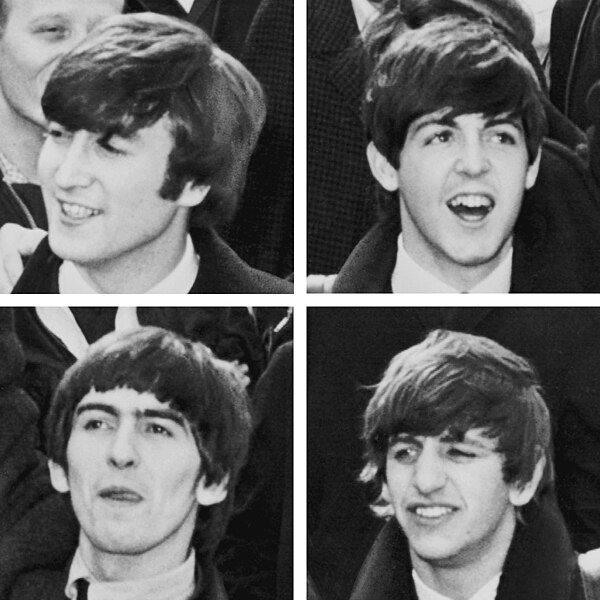
Few bands have shaped modern music as profoundly as The Beatles, and their timeless songs lend themselves beautifully to symphonic interpretation. These four tracks showcase The Beatles’ evolution from innovative rock songwriters to cultural icons, blending classical influences with their unique style to create enduring masterpieces.
Eleanor Rigby
“Eleanor Rigby” stands as one of The Beatles’ most unconventional songs, released in 1966 on the Revolver album. It broke new ground with its lack of traditional rock instrumentation—no guitars or drums—relying instead on a string quartet arranged by George Martin. The lyrics, penned by Paul McCartney, explore themes of loneliness, isolation, and the quiet despair of ordinary lives. With its classical influences and poignant storytelling, “Eleanor Rigby” marked a significant shift in The Beatles’ sound, showing their maturity as artists and their willingness to take risks.
Fun Fact: The name “Eleanor Rigby” was inspired by a combination of sources. Paul McCartney took “Eleanor” from actress Eleanor Bron, who starred in The Beatles’ film Help!, and “Rigby” from a wine shop he saw in Bristol called “Rigby & Evens Ltd.” Although McCartney didn’t realise it at the time, there is a real grave for an Eleanor Rigby in Liverpool, which has since become a popular site for Beatles fans.
Yesterday
Widely regarded as one of the most covered songs of all time, “Yesterday” showcases Paul McCartney’s talent for writing melancholic ballads. The song, released in 1965 on the Help! album, features only McCartney’s vocals accompanied by a string quartet, creating a simple yet haunting arrangement. Its lyrics reflect a sense of regret and longing, capturing universal feelings of loss and nostalgia. This stripped-back style was a bold move for The Beatles, and it marked the beginning of their experimental phase with more classical instrumentation.
Fun Fact: The working title of “Yesterday” was “Scrambled Eggs.” McCartney originally sang, “Scrambled eggs, oh my baby how I love your legs” as placeholder lyrics before the final version took shape.
And I Love Her
A delicate and heartfelt love song from the A Hard Day’s Night album (1964), “And I Love Her” stands out for its acoustic arrangement and romantic simplicity. McCartney’s lyrics are direct and tender, celebrating the purity of love, while George Harrison’s famous guitar riff gives the song its distinctive charm. The song’s gentle melody and understated beauty marked a growing sophistication in The Beatles’ music, moving beyond the high-energy of their early work and foreshadowing their later, more experimental compositions.
Fun Fact: George Harrison came up with the guitar riff that defines “And I Love Her” while they were recording the song. The riff transformed the track from a simple ballad into the iconic piece we know today.
Let It Be
One of The Beatles’ final singles before their breakup, “Let It Be” was written by Paul McCartney and inspired by a dream he had about his mother, Mary, who passed away when he was 14. The song, released in 1970 on the album of the same name, combines elements of gospel with rock and features a soothing, uplifting message of comfort and acceptance in times of hardship. Its orchestral arrangement enhances the song’s spiritual and reflective nature, making it one of the most beloved songs in their catalogue.
Fun Fact: The famous line “Mother Mary comes to me“ in “Let It Be” is not a religious reference, but a tribute to McCartney’s mother, Mary, who passed away when he was a teenager. He has said that her comforting words inspired the song’s theme of hope.
Somewhere Only We Know | Keane
( Feat. Raafik and the KLCO )
Released in 2004 as part of Keane’s debut album Hopes and Fears, “Somewhere Only We Know” became one of the defining indie rock ballads of the 2000s. The song’s lush, piano-driven melody—uncommon in the guitar-dominated world of rock at the time—immediately set Keane apart from their peers. The simplicity of the arrangement allows the emotional weight of the lyrics to shine through, as lead singer Tom Chaplin’s vocal delivery conveys a sense of longing and nostalgia. The song has often been compared to the work of Coldplay and U2 for its anthemic quality and ability to connect with listeners on a deeply personal level.
Lyrically, the song was inspired by Chaplin’s feelings of isolation and the search for a place of emotional refuge. It resonated with audiences worldwide, becoming a timeless indie classic and a frequent go-to for fans seeking a reflective, heartfelt anthem. The band’s ability to fuse emotive lyrics with simple, yet powerful melodies earned them a loyal following and lasting influence in the indie rock scene.
Fun Fact: “Somewhere Only We Know” was written by Keane’s pianist Tim Rice-Oxley, who described the song as being about “drawing strength from a place or experience shared with someone.” The song reflects the idea of finding comfort and connection in a secret place, something Rice-Oxley believes many people can relate to.
Alternative Rock Medley
#1 Crush | Garbage
Originally released as a B-side, “#1 Crush” gained widespread recognition when it was featured on the soundtrack for Romeo + Juliet in 1996. The song’s dark, sultry atmosphere is driven by Shirley Manson’s haunting vocals and its themes of obsession and unrequited love. Its brooding, electronic sound, combined with heavy strings, creates an intense and almost hypnotic effect. The lyrics reflect a deep, almost dangerous infatuation, which resonated with the intense romantic themes of Romeo + Juliet.
Garbage’s fusion of alternative rock with electronic elements helped define the sound of the 90s. With “#1 Crush”, they showcased their ability to blend raw emotion with sophisticated production, a signature style that helped them stand out in the alt-rock scene. The song remains one of the band’s most recognisable tracks and contributed to the moody, atmospheric soundtracks that became popular in the late 90s.
Fun Fact: Shirley Manson has said that “#1 Crush” was one of the first songs where she felt completely free to express her dark side, embracing the song’s obsessive themes without holding back.
Paranoid Android | Radiohead
Released in 1997 as part of their critically acclaimed album OK Computer, “Paranoid Android” is often described as a mini rock opera. With its multiple sections, shifting time signatures, and dystopian themes, the song is a complex commentary on alienation and societal decay. Inspired by a combination of personal experiences and political observations, “Paranoid Android” captures the uncertainty and anxiety of the modern world.
“Paranoid Android” received widespread acclaim, with critics often comparing it to “Bohemian Rhapsody” by Queen and “Happiness Is a Warm Gun” by The Beatles due to its intricate structure and multiple musical segments. The song transitions through various styles, from eerie, introspective moments to chaotic, guitar-driven crescendos, showcasing Radiohead’s ability to push musical boundaries.
Known for their experimental approach, Radiohead blended elements of progressive rock with electronic and avant-garde influences, creating a track that defied mainstream conventions. The dynamic range and complexity of “Paranoid Android” made it one of the defining songs of OK Computer, an album that reshaped the landscape of alternative music.
Fun Fact: The song’s title is a nod to Marvin, the depressed robot from Douglas Adams’ The Hitchhiker’s Guide to the Galaxy, whose melancholic personality aligns with the song’s themes of alienation and existential dread.
Smells Like Teen Spirit | Nirvana
“Smells Like Teen Spirit” is often credited with bringing grunge music into the mainstream and defining the sound of a generation. Written by Kurt Cobain, the song became an anthem of teenage rebellion, capturing the disillusionment and frustration of the youth in the early 90s. Its raw energy, driven by a loud-soft dynamic and Cobain’s raspy vocals, gave the song a visceral edge that resonated with a wide audience.
“Smells Like Teen Spirit” catapulted Nirvana to international fame and cemented their place as one of the most influential bands of the era. The song’s success also marked the beginning of the grunge movement’s dominance in the music scene, influencing countless artists that followed. Despite its simple chord structure, the song’s power lies in its ability to channel raw emotion through minimalistic instrumentation, becoming an anthem for the misunderstood and disillusioned.
Fun Fact: In a 1994 interview, Kurt Cobain revealed that the lyric “Here we are now, entertain us” came from a phrase he’d use to break the ice at parties, reflecting his discomfort in social settings.
Every Breath You Take | The Police
( Feat. Zeela )
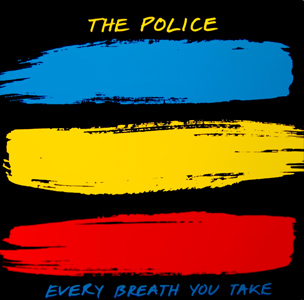
Often mistaken for a love song, “Every Breath You Take” is actually about surveillance, control, and obsession. Released in 1983 on The Police’s album Synchronicity, the song was written by Sting in the aftermath of his tumultuous divorce from Frances Tomelty. The lyrics reflect feelings of possessiveness and longing, framed in a way that feels both intimate and unsettling. The repetitive, almost hypnotic melody, driven by a simple guitar riff and steady drumbeat, contrasts with the darker themes of the song, creating a haunting and emotionally charged atmosphere.
The Police, formed in 1977, became one of the most influential bands of the late 1970s and early 1980s, blending punk, reggae, and new wave to create a unique sound. Led by Sting, whose distinctive voice and songwriting shaped much of the band’s identity, The Police brought an edge to rock music that helped define the post-punk era. Their ability to mix catchy melodies with complex, often dark themes, as seen in “Every Breath You Take”, made them one of the most innovative bands of their time.
Despite its dark undertones, “Every Breath You Take” became one of The Police’s biggest hits, topping the charts for weeks and winning the Grammy Award for Song of the Year in 1984. The song’s universal appeal and ambiguous nature have allowed listeners to interpret it in different ways over the years, further cementing its place as a rock classic. The minimalistic production enhances the track’s emotional intensity, while its simple structure adds to its timeless quality.
Fun Fact: Sting revealed that he wrote “Every Breath You Take” in just half an hour, saying, “I woke up in the middle of the night with that line in my head, sat down at the piano, and had written it in half an hour. The tune itself is generic, an aggregate of hundreds of others, but the words are interesting. It sounds like a comforting love song. I didn’t realise at the time how sinister it is.“
Muse Symphony
( Feat. the KLCO )
Muse is known for their fusion of rock, classical, and electronic influences, making their music perfect for symphonic interpretation. Their grandiose soundscapes, soaring vocals, and dramatic orchestration translate seamlessly into a symphonic setting, highlighting the band’s ability to blend different genres into something epic and cinematic.
Supremacy
“Supremacy” channels the epic scope of James Bond theme music, blending hard rock with orchestral elements to create a sense of power and domination. The song’s lyrics reflect themes of resistance against oppressive forces, a common thread in Muse’s work. The dynamic shifts between soaring vocals and dramatic instrumentation evoke a feeling of rebellion and victory.
Fun Fact: Supremacy was considered as a potential theme song for the James Bond movie Spectre before the role ultimately went to Sam Smith’s Writing’s on the Wall.
Starlight
A song that deals with themes of longing and disconnection, “Starlight” offers a more emotional side to Muse’s discography. The track pairs spacey, uplifting melodies with lyrics that reflect feelings of isolation and the yearning for human connection. Its anthemic sound contrasts with the darker emotions embedded in the lyrics, creating a powerful juxtaposition that resonates with listeners.
Fun Fact: Matt Bellamy revealed that Starlight was written as a love letter to his then-girlfriend, capturing the sense of distance he felt while touring far from home.
MK Ultra
Named after the notorious CIA mind control experiments, “MK Ultra” dives into themes of manipulation, control, and governmental conspiracy. The song’s aggressive tempo and chaotic energy reflect the disorientation and fear associated with such dystopian ideas. The lyrics highlight Muse’s fascination with the intersection of power, surveillance, and psychological control.
Fun Fact: The title “MK Ultra” refers to a real-life CIA program conducted during the 1950s and 1960s, where subjects were exposed to experiments involving drugs, hypnosis, and psychological manipulation.
Knights of Cydonia
Combining futuristic sci-fi themes with spaghetti western motifs, “Knights of Cydonia” is one of Muse’s most cinematic tracks. The galloping rhythm, inspired by old Western films, mixes with space-age themes to create an epic sense of adventure. The song’s grand orchestration and dynamic shifts between intense guitar riffs and atmospheric interludes make it a fan favourite.
Fun Fact: The title “Knights of Cydonia” refers to a region on Mars known as Cydonia, famous for its “Face on Mars” formation. Muse’s fascination with space and sci-fi themes is reflected in the song’s epic, futuristic narrative, blending their love for space exploration with the wild, adventurous energy of a western showdown.
Bohemian Rhapsody | Queen
( Feat. Zeela, Raafik and the KLCO )
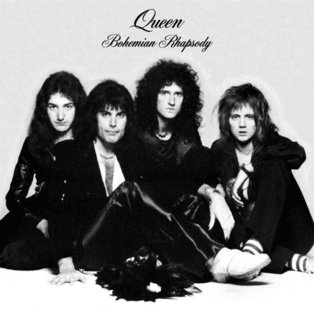
A song that truly needs no introduction, “Bohemian Rhapsody” is often hailed as one of the most ambitious and groundbreaking rock songs ever recorded. Written by Freddie Mercury and released in 1975 as part of Queen’s A Night at the Opera album, the track defies traditional song structures, blending elements of rock, opera, and ballad into a genre-defying masterpiece. The song tells a cryptic and dramatic story, moving through multiple musical sections, from its soft piano introduction to the climactic operatic segment and final hard rock explosion.
Freddie Mercury’s vision for “Bohemian Rhapsody” pushed the boundaries of what a rock song could achieve. Queen’s willingness to experiment with elaborate vocal harmonies and complex arrangements resulted in a track that has become iconic not just for its sound but for its theatricality and creativity. Its innovative structure and Mercury’s unparalleled vocal performance helped cement Queen’s reputation as one of the most inventive rock bands in history.
As a band, Queen was known for their eclecticism, blending genres such as hard rock, progressive rock, glam, and pop. Each band member brought unique strengths: Brian May’s innovative guitar work, Roger Taylor’s powerful drumming, and John Deacon’s melodic bass lines all contributed to their distinctive sound. Together, they created music that was both technically sophisticated and emotionally resonant. Queen’s theatricality and bold experimentation helped shape the rock landscape of the 1970s and 1980s, influencing countless artists across different genres.
Freddie Mercury himself became one of rock’s most iconic figures, known not only for his extraordinary vocal talent but also for his charismatic stage presence and boundary-pushing creativity. His ability to blend flamboyance with vulnerability made him a singular figure in the music world, and his fearlessness in both his musical and personal life inspired generations of musicians and fans alike.
Queen’s influence extended beyond the success of “Bohemian Rhapsody”. They pushed the limits of live performances with their elaborate stage shows, broke barriers with genre-blending music, and contributed to the evolution of the rock anthem. Mercury’s unique approach to songwriting and performance, combined with the band’s groundbreaking use of recording technology, left an indelible mark on the music industry.
Fun Fact: The song was almost never released as a single. Initially, record executives thought “Bohemian Rhapsody” was too long and too unconventional for radio play, clocking in at nearly six minutes. But Freddie Mercury gave a copy to a radio DJ friend, who played it on his show—and listeners loved it. The song went on to top charts around the world, proving the sceptics wrong.
A Heartfelt Thank You to Our Sponsors & Supporters
To all our esteemed sponsors and collaborators, we extend our deepest gratitude. Your generous support and unwavering belief in our mission have been instrumental in bringing this event to life. It is through partnerships like these that we can continue to elevate the arts and create memorable experiences for our audience.
Our journey is enriched by your contributions, and we are proud to have you as part of the Tutan Entertainment family. Your commitment to fostering creativity and promoting cultural exchange is truly commendable.




